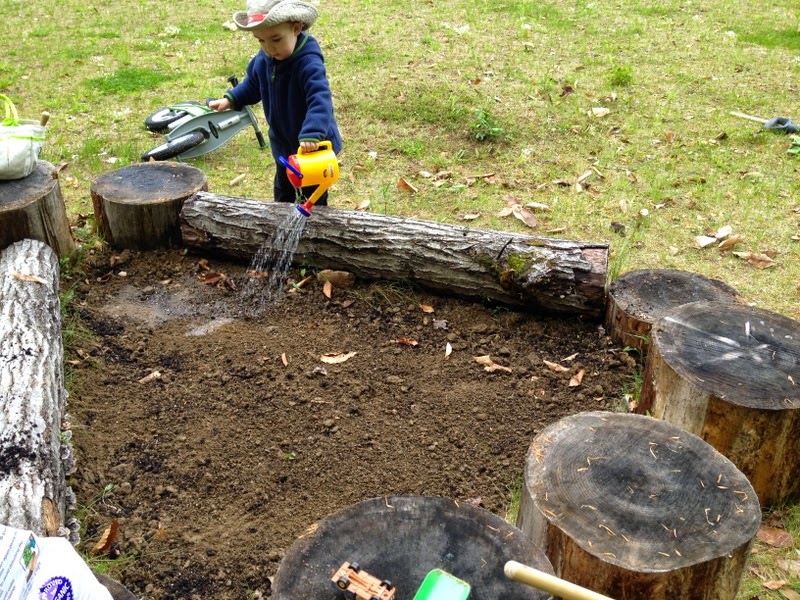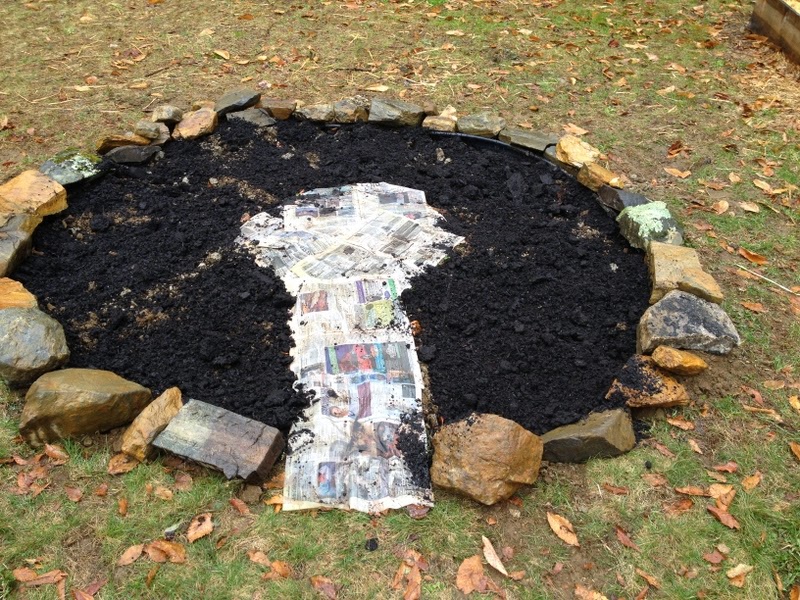Bee Garden
This was actually my oldest sons garden. I tried my hardest not to put any of my own effort into it so that it was his sole responsibility. At the time he was 2.5 and just needed some nudging and reminding to water it every now and then...fortunately this garden was pretty self sufficient.
We planted the garden in the middle of some logs that we have in the yard for the boys to climb on. I helped him to dig off the sod (we didn't have the time or materials to prepare a lasagna style garden like we usually do). Then I asked him to plant the seeds, rake them in, and water it. The seeds we planted just came from a packet I found at our local nursery full of plants that bees love.
Being a bit of a perfectionist, it was a little hard to watch the seeds not being spread evenly around, but I bit my tongue. Once he raked them in they were better distributed anyways.
He collected water from our "rain bucket" (used to catch water from our leaky gutter) with his little watering can and made trips back and forth until the garden had enough to drink.
It was fun to watch him water his garden and notice all the new plants popping out of the ground.
Eventually there were lots of flowers in bloom, lots of bees, and it was a pretty sweet place to hang out and play around.
The funny thing about this garden is because the soil was so rocky and poor, the flowers were miniatures of the ones in our other garden.
At the end of the season, I put in some bonemeal, some compost and some leaves to make the soil a little bit richer. It will be interesting to see any differences this summer if we decide to continue to use that spot as a bee garden. Here is a card I stumbled across with ideas of what you can plant in your very own bee garden:
Birdseed Garden
I was very excited to plant this garden! Prior to this, we didn't have a flower garden, and I was looking forward to having a great excuse to put a lot of time and effort into its implementation. We decided to place it near where we have our bird feeders so we would be able watch the birds feast in the garden. Before this summer, I had never actually seen birds eat seed from flowers, so I was excited to see if they actually flocked to the garden and how they went about dismantling the flowers.
I wanted to try to make it into a keyhole garden, which is a type of garden I read about in Gaiss's Garden: A Guide to Home-Scale Permaculture by Toby Hemenway (pgs. 37-42). A keyhole garden is kinda of just what it sounds like; it's a circular garden with a path to the center so that it resembles a keyhole. Why on earth would you make a garden this shape instead of a square or a rectangle? Well there are several reasons:
- More space for plants. The shape of the garden determines how much of the area can be used for planting as opposed for paths that allow us to reach the plants. Every place we step in the garden compacts and rather destroys the soil making it not plantable. A keyhole garden minimized the space used as a path to one small line from witch you can reach all the plants. In Gaia's Garden, there is an excellent diagram depicting this. It compares the amount of path needed for three different shaped gardens containing 50 square feet of planting. A typical garden with paths in between each row of plants will require 40 square feet of path. Raised bed need 10 square feet of path. A keyhole bed only needs 6 square feet of path.
- More aesthetically pleasing. Bringing curves to a garden takes a away that "cornfield" look that comes from planting in rows. Nature is always curves and meanders around, and having a circular spaced garden "lend surprise and whimsy to a garden" (p. 38).
- Can trap warmth. By aiming the central path south and putting tall plants in the back, the bed creats a U-shaped sun bowl that can create warmth inside for heat-loving plants.
- Easy to water. A single, small sprinkler in the center can easily water the entire bed.
1. First we measured out a 10 foot diameter circle with stones as markers and a 18 inch path with a two foot turn around area in the center. We removed all the sod from the planting space, but you could very well do a lasagna garden right onto the grass layer...we just didn't have the time or materials to get a lot of layers and wanted to give the garden a good start.
2. We lay down wet news paper inside the entire circle (path and planting area) as a weed suppressor. Then we put down a layer of organic compost (made of manure and peat from the Coast of Maine) in the planting area. We also made a border around the entire bed using loose stones from our rock wall.
3. We added several bags of crushed leaves that accumulated in our yard and we collected using a leaf blower/vacuum. We wet the leaves thoroughly to aid in their decomposition.
4. We put down a layer of organic potting soil on top to give the seeds a nice place to germinate. We also placed stones along the path.
5. Finally, we put down Coast of Maine enriching mulch on the path to keep the weeds out. Now it was ready to plant!
I decided to use the diagram I found in Sally Roth's Attracting Birds to Your Backyard (p. 53) as a guide for what to plant in our garden:
By the end of the season I believe I planted Bachelor's buttons, Purple coneflower, cosmos, zinnias, foxtail millet, switch grass, a couple types of sunflowers (Autumn Beauty and Vanilla ice), tickseed, and black eyed susans. Some things, didn't really come up so I had to go get new seeds and try replanting (creeping zinnias). Some things that I started inside didn't transplant well (sunflowers and purple coneflowers) and needed to be replanted...but most didn't have enough time to mature. But some plants ended up doing very well, like the zinnias, foxtail millet, bachelor buttons and cosmos, and the whole family was very excited about their beautiful presence in our yard.
 |
| bachelor buttons were the first to pop up and flowered all summer long |
More importantly though, the birds and the bees loved this garden as well. The most frequent bird visitors by far were were goldfinches, morning doves and chipping sparrows. The doves like to peck around under the cool shade of the flowers green foliage while we delighted in watching the goldfinches' acrobatics as they swung around on the floppy cosmos. Hummingbirds often buzzed along side the bees to sip on the nectar of colorful zinnias.
Since we do not have a bird bath, and it's important to have an easy source of water for our bird friends, I picked up a terra cotta pot base from our local nursery to place on one of the border stones and kept it full of fresh water. I never saw it used as a bird bath per say, but everyday we saw mourning doves and finches perched on the edge enjoying sips of cool water. We even had chipmunks visit the little pool regularly.
If you are interested in starting your very own birdseed garden, there are numerous beautiful plants that you can chose from! Here is a list to help you get started:
- Bachelor's Buttons (Centaurea cyanus)
- Zinnias
- Foxtail Millet (Setaria italica)
- Switch Grass (Panicum virgatum)
- Autumn Joy Sedum (Sedum 'Autumn Joy')
- Black-eyed Susan (Rudbeckia)
- Blazing star (Liatris species)
- Coreopsis (also known as tickseed)
- Cosmos
- Goldenrod (Solidago species)
- Purple coneflower (Echinacea purpurea)
- Purple majesty millet (Pennisetum glaucum 'Purple Majesty')
- Sunflower (Autumn Beauty, Saw-toothed sunflower, Golden Goddess, Mexican sunflower, etc)
Happy planting! The birds and the bees will thank you!

































